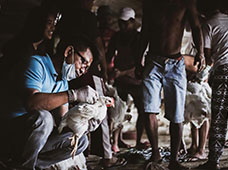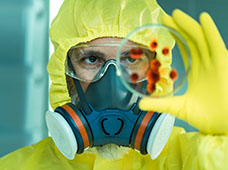ARTICLE
Engaging for
climate
While animal production contributes to greenhouse gas emissions, animal health is also affected by climate change. In 2021, the World Organisation for Animal Health nurtured links between animal health management and climate change actions in response to this growing crisis.
Building Veterinary Services’ climate resilience
Climate change affects animal health in different ways. It alters habitats, water, and feed accessibility, but also triggers fluctuations in animal disease epidemiology. Unusual severe rainfalls, for instance, may have been associated with anthrax outbreaks in some areas of Europe, previously free of the disease for decades. By disrupting natural ecosystems, the evolution of climatic patterns allows for dangerous bacteria, viruses, fungi, and disease-transmitting vectors, such as mosquitos and ticks, to reach new areas where they may cause harm to wildlife and domestic animals.
Increased temperatures in marine and aquatic systems also threaten fisheries and aquaculture. When water temperatures increase, its quality declines as harmful algae proliferate, decreasing water oxygen levels. This, in turn, leads to reduced feeding and growth, all of which can increase the incidence of diseases.
For these reasons, climate change is inherently an animal health issue.
To ensure better preparedness and response to this global threat, the Organisation has increased its focus on climate change. In August 2021, we published a Scientific and Technical Review to assist Members and the international community in becoming better prepared to survive and thrive in the uncertain years to come.
In October 2021, we have also raised awareness on how the control of animal diseases, such as peste des petits ruminants (PPR), can contribute to climate resilience by co-organising a webinar prior to the global climate summit (preCOP26). Healthy goats, that tolerate climate extremes and poor-quality forage, can act as buffers for household consumption and income during climate shocks such as drought. Eradicating PPR, which threatens over 80% of the sheep and goats’ global population, would be a key milestone: this is the aim of the PPR Global Eradication programme.
Monitoring the effects of climate change on animal health
Surveillance is also key in responding to the challenges climate change poses to animal health. Our World Animal Health Information System (WAHIS) helps strengthen the resilience of Veterinary Services when it comes to addressing the health effects of climate change. By providing health data to anticipate high-risk situations and respond with early interventions, WAHIS helps prevent and prepare for health events at the human–animal–ecosystem interface. It also provides information to identify changes in the distribution of diseases such as Lumpy Skin Disease (see below), as well as the associated drivers, contributing to reduce vulnerabilities to the effects of climate change.
We encourage our Members to immediately report new outbreaks linked to climatic events, enabling them to access timely information and better prevent the spread of animal diseases worldwide.
Lowering the carbon footprint of animal production
Preparing to face the effects of climate change on the animal health sector is not enough: at least 14.5% of human-induced greenhouse gas (GHG) emissions come from livestock production, according to estimations from the Food and Agriculture Organization of the United Nations. Animals naturally emit GHGs. And sick or dying animals as well as those not producing efficiently increase the production system’s carbon footprint as they require medical interventions (veterinary visits), disease control interventions (vaccination, culling and carcass management) and can lead to a waste of resources. In other words: keeping animals healthy and caring for their welfare is critical for the environment.
In 2020 and 2021, more than 1,5 million domestic pigs were lost worldwide to African swine fever (ASF), a highly contagious hemorrhagic viral disease. The ASF outbreaks caused tremendous animal suffering and economic loss for farmers. Additionally, the resources used to raise the pigs went to waste. Greenhouse gases were released while fewer animal products were made available for human consumption.
By implementing strategies for the prevention, control and elimination of priority animal diseases, the World Organisation for Animal Health contributes to improving the health and productivity of animals, thus reducing the carbon footprint of animal production.
14.5 %
of human-induced greenhouse gas emissions come from livestock production
supports
750 million
of the world’s poorest people, most affected by climate change
Keeping animals healthy means resources are not wasted, lowering the carbon footprint of animal production.
%
Partnering with UNESCO to keep an eye on the future(s)
As we face the threat of climate change, our future is filled with uncertainty. And with uncertainty comes possibilities for novelty and innovation. We have always worked with our Members to build a better and healthier future for animals and humans. Today, we are taking our forward-thinking approach further.
Since September 2020 and through 2021, we have partnered with UNESCO (United Nations Educational, Scientific and Cultural Organization) to co-design the Futures Literacy Laboratories (FLLs). Futures literacy addresses the need to better act upon an uncertain future by imagining the various scenarios that may occur. Being futures literate enhances our ability to prepare, recover and invent as changes occur. For WOAH, the FLLs present opportunities to sharpen our skills in imagining and anticipating a world increasingly modified by climate change. This empowers us, and our Members, to look at the present differently. By delving into stories and scenarios representing different futures, we can develop capacities to anticipate complexity and uncertainty. Through the practices of foresight and futures literacy we aim to become more resilient and reactive to identify actions that ensure global safety and health while preserving the environment for future generations
ALSO READ

Helping research for better preparedness
Discover

Encouraging global cooperation
Discover

Preventing biothreats
Discover
